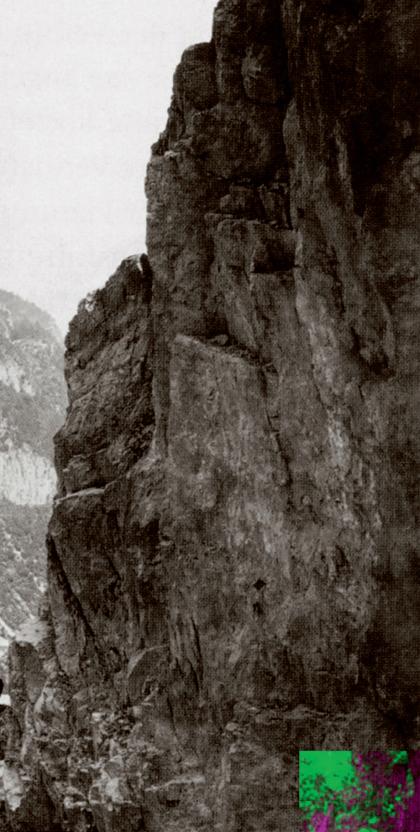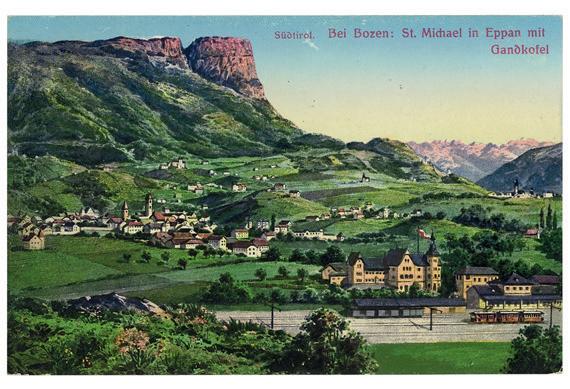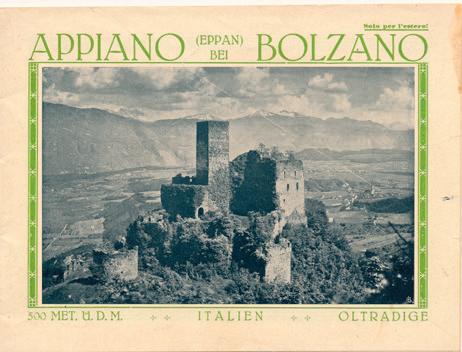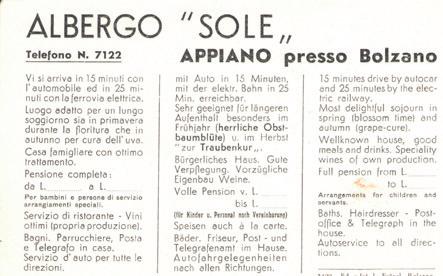
10 minute read
Travel broadens your horizons


Advertisement
… and every traveler has a story to tell … This adage – attributed to the poet M. Claudius – is true for Eppan, too. That's because its evolution from a simply country wine village to a popular vacation destination was a long journey consisting of many steps. Let's take a look at 150 years of tourism in Eppan.
Our little village will someday be a popular holiday destination for aristocrats and citizens from all of Europe?! Th e townsfolk back then would have shaken their heads in disbelief, or would have had no time for such nonsense. It was the Empress Elisabeth of Austria who got the ball rolling when she visited Meran / Merano in the 1870s, thus instantly helping the town to gain notoriety as a spa resort far beyond the country's borders.
Phase One: A health spa with a wholesome climate Eppan's story as a tourist destination begins at about the same time. "On August 25, 1872, the Curative and Civic Improvement Association for the Upper Etsch was found at the Sonne Inn in St. Michael ," intones the cultural advisor Wally Kössler as she reads aloud from old reports. Th e town physician, Dr. Benoni, was the fi rst chairman, and Eppan was granted the designation "climatic curative spa" for people suff ering from heart and circulatory system problems as well as


Cultural advisor Wally Kössler

for asthmatics by the bureaucrats in Vienna. Th e locals already had a brisk business in renting out rooms and apartments for the visitors, and the decision was made to not levy a resort tax. Various positive developments soon followed suit: Th e construction of the Mendelstrasse, the street through the Warth Valley to the provincial capital of Bozen, or the establishment of the Upper Adige railroad for trade. Th ey all helped make Eppan accessible in the 1880s. Rooms were being let at the Zur Sonne Inn in St. Michael, at the Adler in St. Pauls, and at the Rössl in Girlan. "Th ree hostelries which, sadly, have since vanished," says Kössler with regret.
The fi rst luxury hotels, but then a rocky start Around the year 1900, the Hemmerbach Manor was redesigned as the Hotel Eppanerhof, thus realizing the dream of the brickyard owner Franz Mayr of opening up a luxury hotel in St. Michael. Paul Putzer von Reibegg, too, succeeded in from attracting the fi rst international guests – chiefl y nobles from Vienna, but also wealthy visitors from England, Russia, America, and even China – to Eppan. Th is also marked the entrance of Viennese cuisine and the introduction of more-enlightened and progressive thinking to this rural community – in contrast to the conservative ways of the rural populace. But the boom didn't last. "People didn't jump on to the band wagon," reports the cultural advisor. Th ese initial attempts to raise awareness for Eppan as an attractive spa resort also failed due to external events: World War I, the division of Tyrol, the annexation of South Tyrol by Italy, and Fascism. Nevertheless, this period is also marked by visionary ideas. Th us, "Ubald v. Lutz had formalized certain therapeutic approaches such as the grape cure which are still in use today." He redesigned the Liebenburg as a hostelry, initiated guided tours of the wine cellars and mansions, and brought guests to and from his premises by horse-drawn carriage and their baggage by wagon. Several businessmen with an eye for the future made signifi cant advances in the tourism sector in the 1920s, but the eff ects of the Great Depression, the forced Italianization of South Tyrol, the ethnic question, and World War II cannot be underestimated.

Boom with a broad base Aft er the struggle of the fi rst post-war years, locals began to recognize the potential harbored by tourism. Th e German "Economic Miracle" of the 1950s further supercharged developments, and especially farmers' wives welcomed the supplemental income to be had in the tourist sector. Encouraged by local
government offi cial Alois Dellagiacoma, the Tourism and Civic Improvement Association of Eppan – with the Hocheppan Fortress as its offi cial advertising trademark – was established on July 15, 1952. In 1957, the fi rst brochures were printed. In 1958, a "bed fee" of 250 lire was introduced, and in 1960, the association opened an offi ce in the city hall to serve the rapidly rising number of tourists. Th e boom of the 1960s benefi ted private households, farmsteads, and the agricultural sector as a whole. "Practically every household had rooms to let – these were oft en the master bedroom or the children's rooms," remembers Kössler. Holidaymakers were happy to stay with families; they got a taste of authentic rural life. Eppan's wine further helped spread its fame. In 1963, a total of 140,000 overnight stays were registered. Th ere were 33 inns, hostelries, and hotels with 668 beds and 70 private households with 304 beds. Th e local economy thrived as a result. Bars and pastry shops were established, and investments in other branches of the economy were made.
Eppan – The ideal get-away destination 1964 marked the start of a new era with Konrad Dissertori as head of the Tourism and Civic Improvement Association. He collected donations for the tourism agency, encouraged homeowners to improve the facades of their buildings, had signposts and benches installed along hiking trails, promoted the restauration of wayside shrines and chapels. He had modern signage with useful information installed and promoted the establishment of bicycle paths, instituted bicycle rentals, designed an exercise course in the Monticolo Forest, and ensured that municipal garbage pick-up was well regulated. "But his greatest achievement was advertising. Konrad Dissertori was one of the fi rst to recognize the importance of strategic marketing," says Wally Kössler. Eppan's presence at tourism conferences, its involvement in city partnerships, the promotion of advertisement tours by music groups and traditional costume clubs as well as soccer invitationals all bolstered Eppan's reputation as the ideal get-away destination for German tourists. "And our guests remained loyal to us for many years. It became common for stays to be extended to two or even three weeks," says the cultural advisor. Word-of-mouth, private correspondence, contacts with journalists and travel agencies as well as thou-
"The decisive thing is that we work together!"
What is the current standing of Eppan as a tourist destination? Evelyn Falser, President of the Eppan Tourism Association: We have a very good standing. South Tyrol has a good reputation, and Eppan has everything you need for a great vacation. Lakes and mountains in the immediate vicinity, hiking, and culture – it is always the perfect starting-point. After a slight reduction in the average length of stay, since 2021, we've seen stays lengthen again.
A lot of businesses in Eppan are experiencing a "changing of the guard:" How important is the coming generation (see also pg. 32)? We would do well to encourage this new generation to take the reins. Young people want to be shown potentials and perspectives. Young and old alike have to pull together in the business. The younger generation has new ideas and access to social channels. Our guests are getting younger, too. But the sector needs continuity, too – the vast store of experience which the older generation has, their understanding of how to deal with guests, and especially with long-time guests (still the majority of our vacationers).
Evelyn Falser, President of the Eppan Tourism Association.
What steps have to be taken to successfully promote tourism here? The basic attitude towards tourism on the part of the local populace is important. We need their support. Specifi c action to promote quality tourism must be taken to avoid "over-tourism." We have to enhance access to interesting sites and make it easier for tourists to experience them. We have to promote both time-honored and new events. The concept of sustainability must be recognized – e.g., when it comes to mobility. We need to develop and strengthen our position as a premium resort area with great offerings.
"With gratitude and lots of great events."
150 years of tourism in Eppan: How is the anniversary in 2022 being celebrated? Thomas Rauch, Director of the Eppan Tourist Agency: We have a multi-faceted program of events to showcase the anniversary throughout the year (see also pg. XX). There will be a special commemorative publication and a book (published by the Folioverlag publishing house) in which the culture publicist Martin Hanni outlines the 150 years of tourism in Eppan from its very beginnings to the present. In this context, there will be an exhibition at the Lanserhaus in St. Michael Eppan. So-called "walk acts" will be a part of these events. A storytelling café where experts in the tourist sector will tell schoolchildren and other interested parties about developments in the fi eld is also planned. But we will also examine the future of tourism in the context of a panel discussion.
What do we learn when reviewing Eppan's 150-yearlong history of tourism? That yesterday's tourism was quite different than today's tourism. The accommodations have been transformed. The original civic improvement organization has evolved into a modern tourism association. We are no longer just a clearing house for beds; instead, we have developed into a small marketing organization that addresses both locals and visitors.
OUR MOTTO IS: QUALITY, NOT QUANTITY.
Thomas Rauch, Director of the Eppan Tourist Agency
What emotions does this success story elicit in you? Gratitude! We are proud of our origins, but we are completely focused on the future. Our motto is: Quality, not quantity – to strengthen Eppan's position as a sustainable and enjoyable resort region. sands of brochures sent to people in Germany, Austria, and Switzerland made "Eppan" a household word.
The birth of the South Tyrolean Wine Route Dissertori's eff orts led to the founding of the "South Tyrolean Wine Route" committee with the communities stretching all the way from Eppan to Salurn and to the production of the advertising fi lm "South Tyrolean Wine Route – An Ancient German Cultural Landscape." Th e goal: To join forces to launch advertising campaigns on behalf of tourism and also to promote the fruit and wine sector. Since 1971, Eppan added the phrase "on the Wine Route" to its name. Dissertori had 500 almond trees planted along this route to greet vacationers in the springtime. And the guests came in droves. In 1980, 430,000 overnight stays were recorded. Th ere were 146 hostelries with 3,500 beds and 382 private room licenses with 3,000 beds. "We no longer have that many beds," explains Kössler. Th e 1980s were characterized by a degree of stagnation. Th e rooms to let were returned to their use as private residences. We saw more of a new kind of guest – with higher demands.
The journey to quality tourism Beginning in the 1990s, the trend to higher-quality tourism was gaining momentum. Private rooms were returned to private use. Th e concept of "vacationing down on the farm" in conjunction with agricultural undertakings established itself. Simple inns and modest hotels "upped" their game and evolved into three-star, four-star, and even fi ve-star operations. Approached initiated by pioneers in the fi eld are now fi rmly-established components of touristic development. Targeted marketing – which used to be propagated via ads or brochures – has shift ed chiefl y to the Internet. But guests who love coming to Eppan, the appealing landscape, and the hospitality of the locals are all still here. In 2010, Eppan registered 474,117 overnight stays in 65 hostelries with 2,340 beds and 152 private room licenses with 1,323 beds. Wally Kössler sums it up in these words: "On the occasion of the 150th anniversary, we want to increase awareness among the locals of the importance of tourism for Eppan." In the context of this anniversary, there will be festivities, celebrations, a commemorative publication, a book, and an exhibition. So there is a lot to talk about.











